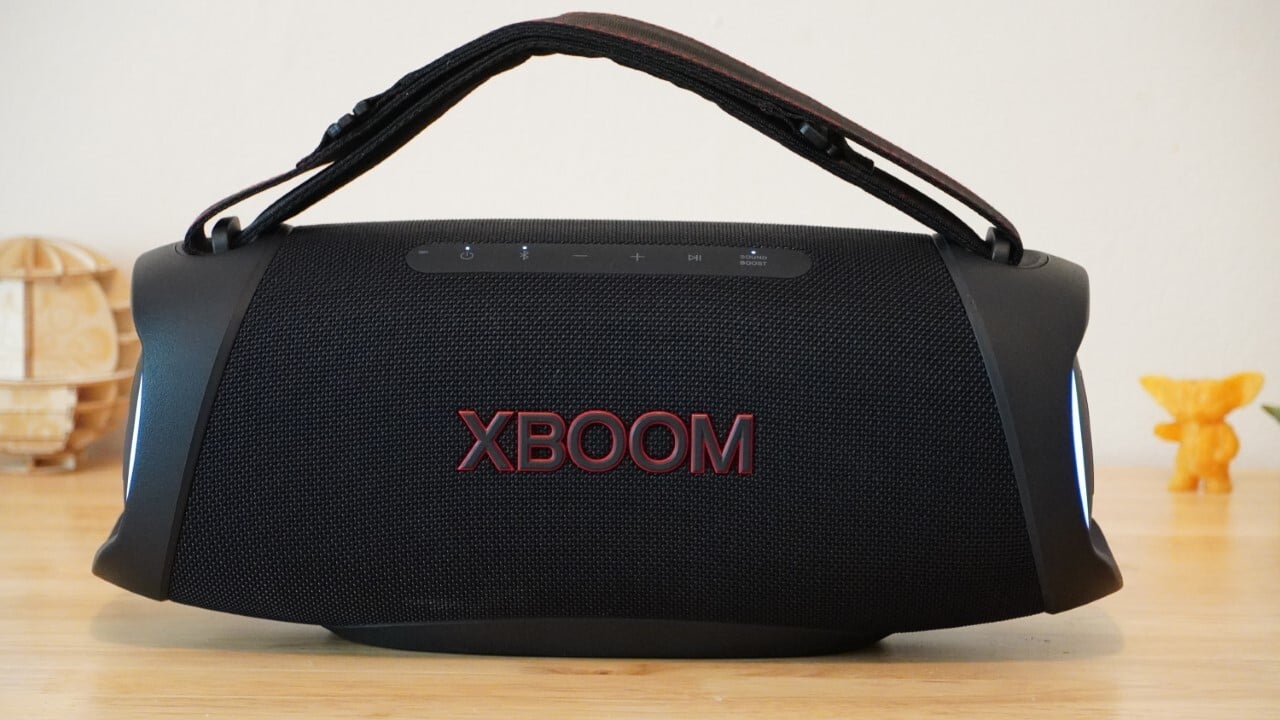-
Pros
- Weatherproof design
- Booming volume
- Adjustable strap
-
Cons
- Expensive
- Mono sound presentation lacks nuance
- No wired audio input
- Bulky DC charger
LG XBOOM Go XG8T Specs
| Bluetooth | |
| Built-In Voice Assistant | None |
| Channels | Mono |
| Physical Connections | USB |
| Portable | |
| Speakerphone | |
| Water-Resistant |
The $379.99 LG Xboom Go XG8T Bluetooth speaker has all the wattage and weatherproofing it needs to operate outdoors, and we enjoy many of its design aspects, including a detachable strap and adjustable LED accents. That said, it doesn't deliver a well-rounded music presentation, belting out mono sound with little room for subtleties. The lack of a 3.5mm aux input and USB-C port are also downsides for the speaker's relatively high price.The waterproof Anker Soundcore Boom Plus 2 provides superior stereo sound, a more modern port selection, and longer battery life for a far more affordable $249.99, so it remains our Editors' Choice pick for midsize portable speakers.
Design: Rugged, With Outdated Connections
The black Xboom Go XG8T is a beefy boombox that measures 5.9 by 14.6 by 5.8 inches (HWD) and weighs 6.6 pounds. The Anker Soundcore Boom Plus 2 is substantially larger and heavier (9.0 by 17.4 by 5.9 inches, 8.4 pounds), though both are primarily plastic affairs. A removable, adjustable strap makes hanging or carrying the Xboom a breeze, while a wide rubber pedestal at its base keeps it in place on the ground.
 (Credit: Mark Knapp)
(Credit: Mark Knapp)Sizable passive radiators cap either end of the speaker, while fabric facades hide an internal 60W tweeter and 60W woofer. (Both operate at a peak of 50W on battery power.) The combination produces mono sound, and LG doesn't specify a frequency range. The Anker speaker delivers slightly more power (140W) in its Bass Up mode and produces stereo audio for reference. Both models have customizable LED arrays around the passive radiators on the sides, though nothing nearly as flashy as what you see on LG's bigger Xboom models like the $599.99 XL7.
As for other design aspects, the Xboom logo on the front can help make sure you are pointing the speaker in the correct direction. On the rear, a rubber panel covers an old-school DC barrel port for charging and a USB-A port for playing files from a USB drive. The speaker is missing both a 3.5mm input for wired audio playback and a USB-C port for modern charging support. The Soundcore Boom Plus 2 offers both.
The LG speaker supports Bluetooth 5.1, the AAC and SBC codecs, and simultaneous connections with up to two devices. Pricier speakers like the $499.99 Sony Ult Field 7 offer the high-res LDAC codec for Android devices, but the LG's drivers can't take advantage of additional nuance anyway (as I discuss later).
A row of controls near the top of the speaker has buttons for power, Bluetooth pairing, volume up and down, playback, and Sound Boost. (The last adds a bit more oomph to audio.) Tap the playback button twice to skip to the next track, or three times to go to the previous one. Holding down the Bluetooth button for two seconds summons your device's voice assistant. Finally, you can answer incoming calls by pressing the playback button, or end them by holding it down for two seconds.
You needn't worry about exposing the XG8T to dust or water, thanks to its IP67 rating; it's safe to use at the beach and around the pool. For comparison, the Soundcore Boom Plus 2 matches the Xboom's waterproof rating but doesn't officially keep out any dust.
 (Credit: Mark Knapp)
(Credit: Mark Knapp)The speaker seems to live up to LG's claim of a 15-hour battery life; when I played audio for three hours at 50% volume and with Sound Boost active, the battery dropped by 25%. Some combination of lowering the volume level, deactivating the Sound Boost mode, and turning off the LEDs should allow the battery to hit the expected mark. That said, the included 65W charging brick is downright bulky and doesn't even charge the device quickly—you must plug in for three hours to fully recharge the unit. For comparison, the aforementioned Anker speaker lasts up to 20 hours on its battery and can fully recharge via USB-C in three hours. Both support charging external devices.
App Experience: Basic Controls
The LG Xboom app (available for Android and iOS) isn't essential for operating the speaker, but you need it to customize the LEDs. A handful of color presets and some custom palettes are available, and you can tweak the brightness, too.
Otherwise, you can adjust playback volume, manage audio playback, switch between the standard and Sound Boost modes, and access a six-band EQ.
Finally, the app offers the ability to link multiple LG Xboom speakers via the Party Link feature or a second XG8T for stereo playback. If you have multiple devices connected, you can also specify whether you want to prioritize audio from the first or let the two interrupt each other.
Sound Quality: Booming and Boisterous
The Xboom Go XG8T is powerful enough to pump out sound you could catch from the far end of a football field. It commits to providing maximum volume over everything else, employing its internal drivers for this purpose rather than stereo sound (which would be difficult to enjoy from this type of speaker, anyway). Unfortunately, audio sounds harsh at top volumes. It hurts to listen to the speaker at even 70% in the same room, and the audio quickly becomes uncomfortable from 10 feet away.
Kendrick Lamar's "Loyalty" demonstrates the LG's audio capabilities well. While the track starts with bright vocals and instrumentation, the 34-second mark brings some seriously deep sub-bass. The drivers manage to punch a few of those notes with force, though they noticeably miss others. The song also makes it clear that the Sound Boost mode is essential for playback; without it, the bass falls flat.
 (Credit: Mark Knapp)
(Credit: Mark Knapp)For energetic tracks like The Knife's "Silent Shout," the speaker performs better. Its tweeter helps the synth lines shine at the upper end of the mix, while the woofer pumps out the near-constant kick drum and bass pulses. That said, the mid-bass range us weak at times, making for a less nuanced presentation. I played a tone sweep to check my impressions and heard a huge dip between 100Hz and 160Hz. Any notes in this range will fall flat. I also noticed a subtler dip between 1kHz and 1.4kHz, for reference.
On Bill Callahan's "Drover," the speaker doesn't struggle to hit notes and presents Callahan's baritone vocals powerfully. The drum hits boom, and the various strings poke out in the upper registers. But the Xboom nevertheless does a poor job of presenting the subtler elements. This tune plays with space thoroughly, and the mono audio production fails to capture that sense. The strings merely pop up where they should swoop in, as did the wailing electric guitar. The drivers lose other details, as well; the plucking staccato of strings at about the 1:30 mark is almost undetectable. Overall, raw tracks like this simply sound empty.
The XG8T includes a mic for speakerphone functionality, though we doubt many people will use it as such.
Verdict: Loud But Unsophisticated Sound
The LG Xboom Go XG8T is a fine Bluetooth speaker if you want a loud boombox you can sling over your shoulder and take along on outdoor adventures. But it doesn't do enough to set itself apart from the competition, especially given its high price. You're much better off with the Editors' Choice-winning Anker Soundcore Boom Plus 2, which offers a more powerful stereo driver setup and more convenient connection options for $130 less. The Anker is not quite as durable, however, so there's reason to consider the LG if you plan to use it in dusty or dirty environments.

